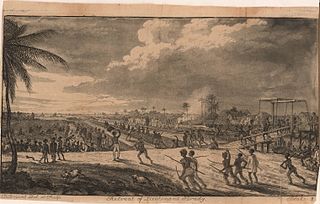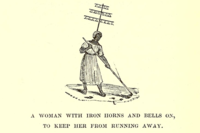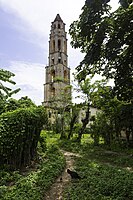The slave narrative is a type of literary genre involving the (written) autobiographical accounts of enslaved persons, particularly Africans enslaved in the Americas, though many other examples exist. Over six thousand such narratives are estimated to exist; about 150 narratives were published as separate books or pamphlets. In the United States during the Great Depression (1930s), more than 2,300 additional oral histories on life during slavery were collected by writers sponsored and published by the Works Progress Administration, a New Deal program. Most of the 26 audio-recorded interviews are held by the Library of Congress.

The Atlantic slave trade or transatlantic slave trade involved the transportation by slave traders of enslaved African people to the Americas. European slave ships regularly used the triangular trade route and its Middle Passage. Europeans established a coastal slave trade in the 15th century and trade to the Americas began in the 16th century, lasting through the 19th century. The vast majority of those who were transported in the transatlantic slave trade were from Central Africa and West Africa and had been sold by West African slave traders to European slave traders, while others had been captured directly by the slave traders in coastal raids. European slave traders gathered and imprisoned the enslaved at forts on the African coast and then brought them to the Americas. Some Portuguese and Europeans participated in slave raids. As the National Museums Liverpool explains: "European traders captured some Africans in raids along the coast, but bought most of them from local African or African-European dealers." Many European slave traders generally did not participate in slave raids because life expectancy for Europeans in sub-Saharan Africa was less than one year during the period of the slave trade because of malaria that was endemic in the African continent. Portuguese coastal raiders found that slave raiding was too costly and often ineffective and opted for established commercial relations.

The history of the Caribbean reveals the region's significant role in the colonial struggles of the European powers since the 15th century. In the modern era, it remains strategically and economically important. In 1492, Christopher Columbus landed in the Caribbean and claimed the region for Spain. The following year, the first Spanish settlements were established in the Caribbean. Although the Spanish conquests of the Aztec empire and the Inca empire in the early sixteenth century made Mexico and Peru more desirable places for Spanish exploration and settlement, the Caribbean remained strategically important.
Plantations are farms specializing in cash crops, usually mainly planting a single crop, with perhaps ancillary areas for vegetables for eating and so on. Plantations, centered on a plantation house, grow crops including cotton, cannabis, coffee, tea, cocoa, sugar cane, opium, sisal, oil seeds, oil palms, fruits, rubber trees and forest trees. Protectionist policies and natural comparative advantage have sometimes contributed to determining where plantations are located.

Sugar plantations in the Caribbean were a major part of the economy of the islands in the 18th, 19th, and 20th centuries. Most Caribbean islands were covered with sugar cane fields and mills for refining the crop. The main source of labor, until the abolition of chattel slavery, was enslaved Africans. After the abolition of slavery, indentured laborers from India, China, Portugal and other places were brought to the Caribbean to work in the sugar industry. These plantations produced 80 to 90 percent of the sugar consumed in Western Europe, later supplanted by European-grown sugar beet.

Slavery in the British and French Caribbean refers to slavery in the parts of the Caribbean dominated by France or the British Empire.

Slavery in the Spanish American viceroyalties included indigenous peoples, enslaved people from Africa, and enslaved people from Asia. The economic and social institution of slavery existed throughout the Spanish Empire including Spain itself. Enslaved Africans were brought over to the continent for their labour, indigenous people were enslaved until the 1543 laws that prohibited it.

Engenho is a colonial-era Portuguese term for a sugar cane mill and the associated facilities. In Spanish-speaking countries such as Cuba and Puerto Rico, they are called ingenios. Both words mean engine. The word engenho usually only referred to the mill, but it could also describe the area as a whole including land, a mill, the people who farmed and who had a knowledge of sugar production, and a crop of sugar cane. A large estate was required because of the massive amount of labor needed to yield refined sugar, molasses, or rum from raw sugar cane. These estates were prevalent in Brazil, Cuba, Dominican Republic, and other countries in the Caribbean. Today, Brazil is still one of the world's major producers of sugar.

Moses Roper was an African American abolitionist, author and orator. He wrote an influential narrative of his enslavement in the United States in his Narrative of the Adventures and Escape of Moses Roper from American Slavery and gave thousands of lectures in Great Britain and Ireland to inform the European public about the brutality of American slavery.
Valle de los Ingenios, also named Valley de los Ingenios or Valley of the Sugar Mills, is a series of three interconnected valleys about 12 kilometres (7.5 mi) outside of Trinidad, Cuba. The three valleys, San Luis, Santa Rosa, and Meyer, were a centre for sugar production from the late 18th century until the late 19th century. At the peak of the industry in Cuba there were over fifty sugar cane mills in operation in the three valleys, with over 30,000 slaves working in the mills and on the sugar cane plantations that surrounded them.

Slavery in Brazil began long before the first Portuguese settlement. Later, colonists were heavily dependent on indigenous labor during the initial phases of settlement to maintain the subsistence economy, and natives were often captured by expeditions of bandeirantes. The importation of African slaves began midway through the 16th century, but the enslavement of indigenous peoples continued well into the 17th and 18th centuries. Europeans and Chinese were also enslaved.
Jack Gladstone was an enslaved Guianese man who led the Demerara rebellion of 1823, one of the large slave rebellions in the British Empire. He was captured and tried after the rebellion, and deported.

The Demerara rebellion of 1823 was an uprising involving between 9,000 and 12,000 slaves that took place in the British colony of Demerara-Essequibo in what is now Guyana. The exact number of how many took part in the uprising is a matter of debate. The rebellion began on 18 August 1823 and lasted for two days. Their goal was full emancipation. The uprising was triggered by a widespread but mistaken belief that Parliament had passed a law that abolished slavery and that this was being withheld by the colonial rulers. Instigated chiefly by Jack Gladstone, an enslaved man from the "Success" plantation, the rebellion also involved his father, Quamina, and other senior members of their church group. Its English pastor, John Smith, was implicated.
Buckra or Backra is a term of West African origin. It is mainly used in the Caribbean and the Southeast United States. Originally, it was used by slaves to address their white owners. Later, the meaning was broadened to generally describe white people.

Plantation complexes were common on agricultural plantations in the Southern United States from the 17th into the 20th century. The complex included everything from the main residence down to the pens for livestock. Until the abolition of slavery, such plantations were generally self-sufficient settlements that relied on the forced labor of enslaved people.

The Slave Route Project is a UNESCO initiative officially launched in 1994 in Ouidah, Benin. In studying the causes, the modalities and the consequences of slavery and the slave trade, the project seeks to enhance the understanding of diverse histories and heritages stemming from this global tragedy.

Afro-Curaçaoans are people from the island of Curaçao of fully or partially African descent. They make up the majority of Curaçao's population.

Slavery in Cuba was a portion of the larger Atlantic slave trade that primarily supported Spanish plantation owners engaged in the sugarcane trade. It was practiced on the island of Cuba from the 16th century until it was abolished by Spanish royal decree on October 7, 1886.

Carlota Lucumí, also known as La Negra Carlota was an African-born enslaved Cuban woman of Yoruba origin. Carlota, alongside fellow enslaved Lucumí Ferminia, was known as a leader of the slave rebellion at the Triunvirato plantation in Matanzas, Cuba during the Year of the Lash in 1843–1844. Together with Ferminia Lucumí, Carlota led the slave uprising of the sugar mill "Triunvirato" in the province of Matanzas, Cuba on November 5, 1843.
The Cry of Yara was a declaration, battle cry, and uprising in eastern Cuba on 10 October 1868, initiating the Ten Years' War.















